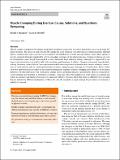Files in this item
Muscle cramping during exercise : causes, solutions and questions remaining
Item metadata
| dc.contributor.author | Maughan, Ronald | |
| dc.contributor.author | Shirreffs, Susan M. | |
| dc.date.accessioned | 2019-11-07T10:30:02Z | |
| dc.date.available | 2019-11-07T10:30:02Z | |
| dc.date.issued | 2019-11-06 | |
| dc.identifier | 260273396 | |
| dc.identifier | 685787a3-ca06-418a-84b1-e65d239b5d18 | |
| dc.identifier | 85074938333 | |
| dc.identifier | 000494786900009 | |
| dc.identifier.citation | Maughan , R & Shirreffs , S M 2019 , ' Muscle cramping during exercise : causes, solutions and questions remaining ' , Sports Medicine , vol. Online First . https://doi.org/10.1007/s40279-019-01162-1 | en |
| dc.identifier.issn | 0112-1642 | |
| dc.identifier.uri | https://hdl.handle.net/10023/18871 | |
| dc.description.abstract | Muscle cramp is a temporary but intense and painful involuntary contraction of skeletal muscle that can occur in many different situations. The causes of, and cures for, the cramps that occur during or soon after exercise remain uncertain, although there is evidence that some cases may be associated with disturbances of water and salt balance, while others appear to involve sustained abnormal spinal reflex activity secondary to fatigue of the affected muscles. Evidence in favour of a role for dyshydration comes largely from medical records obtained in large industrial settings, although it is supported by one large-scale intervention trial and by field trials involving small numbers of athletes. Cramp is notoriously unpredictable, making laboratory studies difficult, but experimental models involving electrical stimulation or intense voluntary contractions of small muscles held in a shortened position can induce cramp in many, although not all, individuals. These studies show that dehydration has no effect on the stimulation frequency required to initiate cramping and confirm a role for spinal pathways, but their relevance to the spontaneous cramps that occur during exercise is questionable. There is a long history of folk remedies for treatment or prevention of cramps; some may reduce the likelihood of some forms of cramping and reduce its intensity and duration, but none are consistently effective. It seems likely that there are different types of cramp that are initiated by different mechanisms; if this is the case, the search for a single strategy for prevention or treatment is unlikely to succeed. | |
| dc.format.extent | 10 | |
| dc.format.extent | 952694 | |
| dc.language.iso | eng | |
| dc.relation.ispartof | Sports Medicine | en |
| dc.subject | RC1200 Sports Medicine | en |
| dc.subject.lcc | RC1200 | en |
| dc.title | Muscle cramping during exercise : causes, solutions and questions remaining | en |
| dc.type | Journal item | en |
| dc.contributor.institution | University of St Andrews. School of Medicine | en |
| dc.contributor.institution | University of St Andrews. Education Division | en |
| dc.identifier.doi | 10.1007/s40279-019-01162-1 | |
| dc.description.status | Peer reviewed | en |
| dc.date.embargoedUntil | 2019-11-06 |
This item appears in the following Collection(s)
Items in the St Andrews Research Repository are protected by copyright, with all rights reserved, unless otherwise indicated.

